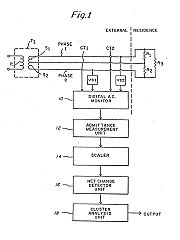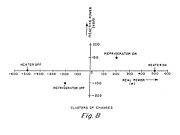
Nonintrusive load monitoring
Encyclopedia
Nonintrusive Load Monitoring (NILM), or Nonintrusive Appliance Load Monitoring, is a process for analyzing changes in the voltage and current going into a house and deducing what appliances are used in the house as well as their individual energy consumption. Electric meters with NILM technology are used by utility companies to survey the specific uses of electric power in different homes. NILM is considered a low cost alternative to attaching individual monitors on each appliance. It does, however, present privacy concerns.
, Ed Kern and Fred Schweppe of MIT in the early 1980s with funding from the Electric Power Research Institute
.
 The basic process is described in . As shown in figure 1 from the patent, a digital AC monitor is attached to the single-phase power going into a residence. Changes in the voltage and current are measured (i.e. admittance measurement unit), normalized (Scaler) and recorded (Net Change Detector Unit). A cluster analysis is then performed to identify when different appliances are turned on and off. If a 60-watt bulb is turned on, for example, followed by a 100 watt bulb being turned on, followed by the 60 watt bulb being turned off followed by the 100 watt bulb being turned off, the NALM unit will match the on and off signals from the 60 watt bulb and the on and off signals from the 100 watt bulb to determine how much power was used by each bulb and when. The system is sufficiently sensitive that individual 60 watt bulbs can be discriminated due to the normal variations in actual power draw of bulbs with the same nominal rating. (e.g. one bulb might draw 61 watts, another 62 watts).
The basic process is described in . As shown in figure 1 from the patent, a digital AC monitor is attached to the single-phase power going into a residence. Changes in the voltage and current are measured (i.e. admittance measurement unit), normalized (Scaler) and recorded (Net Change Detector Unit). A cluster analysis is then performed to identify when different appliances are turned on and off. If a 60-watt bulb is turned on, for example, followed by a 100 watt bulb being turned on, followed by the 60 watt bulb being turned off followed by the 100 watt bulb being turned off, the NALM unit will match the on and off signals from the 60 watt bulb and the on and off signals from the 100 watt bulb to determine how much power was used by each bulb and when. The system is sufficiently sensitive that individual 60 watt bulbs can be discriminated due to the normal variations in actual power draw of bulbs with the same nominal rating. (e.g. one bulb might draw 61 watts, another 62 watts).
 The system can measure both reactive power and real power. Hence two appliances with the same total power draw can be distinguished by differences in their complex impedance. As shown in figure 8 from the patent, for example, a refrigerator electric motor and a pure resistive heater can be distinguished in part because the electric motor has significant changes in reactive power when it turns on and off, whereas the heater has almost none.
The system can measure both reactive power and real power. Hence two appliances with the same total power draw can be distinguished by differences in their complex impedance. As shown in figure 8 from the patent, for example, a refrigerator electric motor and a pure resistive heater can be distinguished in part because the electric motor has significant changes in reactive power when it turns on and off, whereas the heater has almost none.
NILM systems can also identify appliances with a series of individual changes in power draw. These appliances are modeled as finite state machines. A dishwasher, for example, has heaters and motors that turn on and off during a typical dish washing cycle. These will be identified as clusters, and power draw for the entire cluster will be recorded. Hence “dishwasher” power draw can be identified as opposed to “Resistor heating unit” and “Electric motor”.
If the NILM is running remotely at a utility or by a third party, the homeowner may not know that their behavior is being monitored and recorded.
A stand-alone in home system, under the control of the user, can provide feedback about energy use, without revealing information to others. Drawing links between their behavior and energy consumption may help reduce energy consumption, improve efficiency, flatten peak loads, save money, or balance appliance use with green energy availability. This form of disaggregation could be good enough to create a bill or footprint for each of your appliances automatically over a period of time. However the use of a stand-alone system does not protect one from remote monitoring.
The accuracy and capability of this technology is still developing and is not 100% reliable in near-real-time, such that complete information is accumulated and analyzed over periods ranging from minutes to hours.
Background and theory
Nonintrusive Load Monitoring was invented by George W. HartGeorge W. Hart
George William Hart is a geometer who expresses himself both artistically and academically. He is also a research professor in the department of computer science at the State University of New York in Stony Brook, New York....
, Ed Kern and Fred Schweppe of MIT in the early 1980s with funding from the Electric Power Research Institute
Electric Power Research Institute
The Electric Power Research Institute conducts research on issues related to the electric power industry in USA. EPRI is a nonprofit organization funded by the electric utility industry. EPRI is primarily a US based organization, receives international participation...
.


NILM systems can also identify appliances with a series of individual changes in power draw. These appliances are modeled as finite state machines. A dishwasher, for example, has heaters and motors that turn on and off during a typical dish washing cycle. These will be identified as clusters, and power draw for the entire cluster will be recorded. Hence “dishwasher” power draw can be identified as opposed to “Resistor heating unit” and “Electric motor”.
Applications
- NILM systems are used to perform surveys of both residential and commercial energy consumption.
- NILM algorithms have also been proposed for use in detecting drunk driving.
Privacy Concerns
NILM can detect what types of appliances people have and their behavioral patterns. Patterns of energy use may indicate behavior patterns, such as routine times that nobody is at home, or embarrassing or illegal behavior of residents. It could, for example, reveal when the occupants of a house are using the shower, or when individual lights are turned on and off.If the NILM is running remotely at a utility or by a third party, the homeowner may not know that their behavior is being monitored and recorded.
A stand-alone in home system, under the control of the user, can provide feedback about energy use, without revealing information to others. Drawing links between their behavior and energy consumption may help reduce energy consumption, improve efficiency, flatten peak loads, save money, or balance appliance use with green energy availability. This form of disaggregation could be good enough to create a bill or footprint for each of your appliances automatically over a period of time. However the use of a stand-alone system does not protect one from remote monitoring.
The accuracy and capability of this technology is still developing and is not 100% reliable in near-real-time, such that complete information is accumulated and analyzed over periods ranging from minutes to hours.
See also
- Smart meterSmart meterA smart meter is usually an electrical meter that records consumption of electric energy in intervals of an hour or less and communicates that information at least daily back to the utility for monitoring and billing purposes. Smart meters enable two-way communication between the meter and the...
- Google PowerMeterGoogle PowerMeterGoogle PowerMeter was a software project of Google's philanthropic arm, Google.org, to help consumers track their home electricity usage. The development of the software was part of an effort by Google to invest in renewable energy, electricity grid upgrades, and other measures that would reduce...
- Home energy monitorHome energy monitorA home energy monitor provides prompt, convenient feedback on electrical or other energy use. Devices may also display cost of energy used, and estimates of greenhouse gas emissions...
- Energy monitoring and targetingEnergy monitoring and targetingEnergy monitoring and targeting is an energy efficiency technique based on the standard management axiom stating that “you cannot manage what you cannot measure”...

